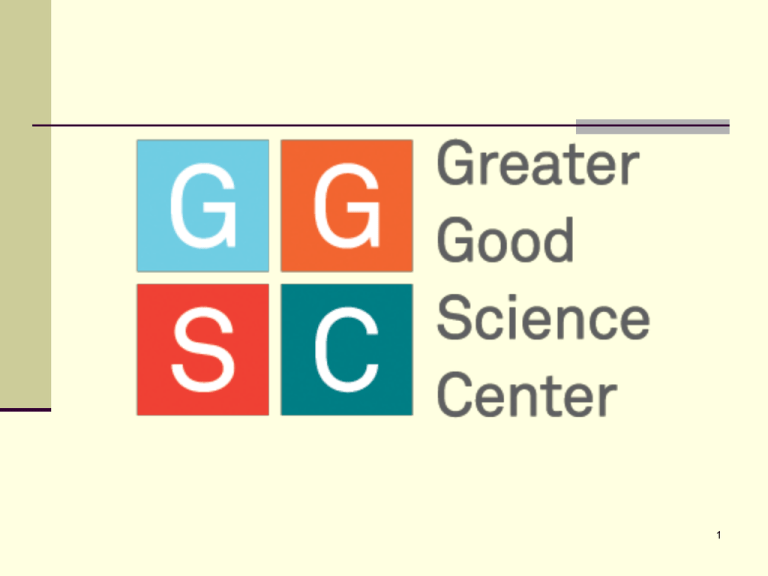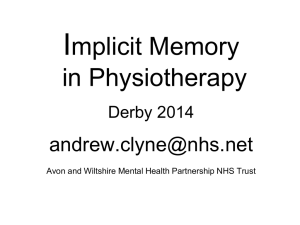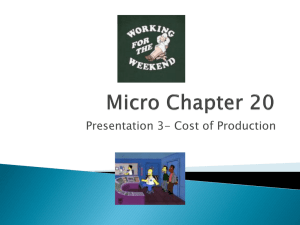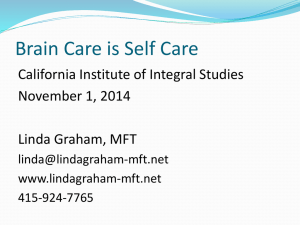
1
The Greater Good Science Center
Resources for a compassionate and resilient society
Online Magazine: Find award-winning articles,
parenting blog, videos, podcasts, and more at
www.GreaterGoodScience.org
Events: “The Science of A Meaningful Life”
Science: Research fellowships
Books: Born To Be Good, The Compassionate
Instinct, Raising Happiness, Are We Born Racist?
Taking in the Good
Greater Good Science Center
UC Berkeley
October 15, 2011
Rick Hanson, Ph.D.
The Wellspring Institute for Neuroscience and Contemplative Wisdom
www.WiseBrain.org
www.RickHanson.net
drrh@comcast.net
3
Topics
Perspectives
Brain basics
Grounding the mind in nature
Self-directed neuroplasticity
On your own side
The evolving brain
The negativity bias
Threat reactivity
Inner resources and implicit memory
Taking in the good
Heal old pain
Natural happiness
4
Perspectives
5
The history of science is rich in the example
of the fruitfulness of bringing
two sets of techniques, two sets of ideas,
developed in separate contexts
for the pursuit of new truth,
into touch with one another.
J. Robert Oppenheimer
6
Common - and Fertile - Ground
Neuroscience
Psychology
Contemplative Practice
7
"We ask, 'What is a thought?’
We don't know,
yet we are thinking continually."
Venerable Ani Tenzin Palmo
8
Domains of Intervention
We can intervene in three domains:
World (including relationships)
Body
Mind
All three are important. And they work together.
We have limited influence over world and body.
In the mind:
Much more influence
Changes are with us wherever we go
9
Brain Basics
10
11
A Neuron
12
The Connectome - 2
Hagmann, et al., 2008, PLoS Biology, 6:1479-1493
13
Brain Basics
Size:
3 pounds of tofu-like tissue
1.1 trillion brain cells
100 billion “gray matter" neurons
Activity:
Always on 24/7/365 - Instant access to information on demand
20-25% of blood flow, oxygen, and glucose
Speed:
Neurons firing around 5 to 50 times a second (or faster)
Signals crossing your brain in a tenth of a second
Connectivity:
Typical neuron makes ~ 5000 connections with other neurons:
~ 500 trillion synapses
Complexity:
Potentially 10 to the millionth power brain states
14
Grounding the Mind in Nature
15
Evolution is a tinkerer. In living organisms, new
capabilities are achieved by modifying existing
molecules slightly and adjusting their interaction with
other existing molecules.
Science has found surprisingly few proteins that are
truly unique to the human brain and no signaling
systems that are unique to it.
All life, including the substrate of our thoughts and
memories, is composed of the same building blocks.
Eric R. Kandel
16
17
18
All cells have specialized functions. Brain cells have
particular ways of processing information and
communicating with each other. Nerve cells form
complete circuits that carry and transform information.
Electrical signaling represents the language of mind, the
means whereby nerve cells, the building blocks of the
brain, communicate with one another over great
distances. Nerve cells generate electricity as a means
of producing messages.
All animals have some form of mental life that reflects the
architecture of their nervous system.
Eric R. Kandel
19
The Mind/Brain System
“Mind” = flow of information within the nervous system:
Information is represented by the nervous system.
Most mind is unconscious; awareness is an aspect of mind.
The headquarters of the nervous system is the brain.
In essence then, apart from hypothetical transcendental factors, the
mind is what the brain does.
Brain = necessary, proximally sufficient condition for mind:
The brain depends on the nervous system, which intertwines with
and depends on other bodily systems.
These systems in turn intertwine with and depend upon nature and
culture, both presently and over time.
And as we’ll see, the brain also depends on the mind.
20
Self-Directed Neuroplasticity
21
Fact #1
As your brain changes, your mind changes.
22
Ways That Brain Can Change Mind
For better:
A little caffeine: more alertness
Thicker insula: more self-awareness, empathy
More left prefrontal activation: more happiness
For worse:
Intoxication; imbalances in neurotransmitters
Concussion, stroke, tumor, Alzheimer’s
Cortisol-based shrinkage of hippocampus: less
capacity for contextual memory
23
Fact #2
As your mind changes, your brain changes.
Immaterial mental activity maps to material neural activity.
This produces temporary changes in your brain and lasting ones.
Temporary changes include:
Alterations in brainwaves (= changes in the firing patterns of
synchronized neurons)
Increased or decreased use of oxygen and glucose
Ebbs and flows of neurochemicals
24
The Rewards of Love
25
Christian Nuns, Recalling
Profound Spiritual Experiences
Beauregard, et al., Neuroscience Letters, 9/25/06
26
Mind Changes Brain in Lasting Ways
What flows through the mind sculpts your brain.
Immaterial experience leaves material traces behind.
Increased blood/nutrient flow to active regions
Altered epigenetics (gene expression)
“Neurons that fire together wire together.”
Increasing excitability of active neurons
Strengthening existing synapses
Building new synapses; thickening cortex
Neuronal “pruning” - “use it or lose it”
27
Lazar, et al. 2005.
Meditation
experience is
associated
with increased
cortical thickness.
Neuroreport, 16,
1893-1897.
28
Honoring Experience
One’s experience matters.
Both for how it feels in the moment
and for the lasting residues it leaves behind,
woven into the fabric of a person’s brain and being.
29
Fact #3
You can use your mind
to change your brain
to change your mind for the better.
This is self-directed neuroplasticity.
How to do this, in skillful ways?
30
On Your Own Side
31
The Power of Mindfulness
Attention is like a spotlight, illuminating what it rests upon.
Because neuroplasticity is heightened for what’s in the
field of focused awareness, attention is also like a vacuum
cleaner, sucking its contents into the brain.
Directing attention skillfully is therefore a fundamental way
to shape the brain - and one’s life over time.
The education of attention
would be an education par excellence.
William James
32
The good life, as I conceive it, is a happy life.
I do not mean that if you are good you will be happy;
I mean that if you are happy you will be good.
Bertrand Russell
33
If one going down into a river,
swollen and swiftly flowing,
is carried away by the current -how can one help others across?
The Buddha
34
Self-Compassion
Compassion is the wish that a being not suffer, combined with
sympathetic concern. Self-compassion simply applies that to
oneself. It is not self-pity, complaining, or wallowing in pain.
Studies show that self-compassion buffers stress and increases
resilience and self-worth.
But self-compassion is hard for many people, due to feelings of
unworthiness, self-criticism, or “internalized oppression.” To
encourage the neural substrates of self-compassion:
Get the sense of being cared about by someone else.
Bring to mind someone you naturally feel compassion for
Sink into the experience of compassion in your body
Then shift the compassion to yourself, perhaps with phrases like:
“May I not suffer. May the pain of this moment pass.”
35
“Anthem”
Ring the bells that still can ring
Forget your perfect offering
There is a crack in everything
That’s how the light gets in
That’s how the light gets in
Leonard Cohen
36
The Evolving Brain
37
Evolution
~ 4+ billion years of earth
3.5 billion years of life
650 million years of multi-celled organisms
600 million years of nervous system
~ 200 million years of mammals
~ 60 million years of primates
~ 6 million years ago: last common ancestor with chimpanzees,
our closest relative among the “great apes” (gorillas,
orangutans, chimpanzees, bonobos, humans)
2.5 million years of tool-making (starting with brains 1/3 our size)
~ 150,000 years of homo sapiens
~ 50,000 years of modern humans
~ 5000 years of blue, green, hazel eyes
38
Evolutionary History
The Triune Brain
39
Three Stages of Brain Evolution
Reptilian:
Brainstem, cerebellum, hypothalamus
Reactive and reflexive
Avoid hazards
Mammalian:
Limbic system, cingulate, early cortex
Memory, emotion, social behavior
Approach rewards
Human:
Massive cerebral cortex
Abstract thought, language, cooperative planning, empathy
Attach to “us”
40
41
42
Home Base of the Human Brain
When not threatened, ill, in pain, hungry, upset, or
chemically disturbed, most people settle into being:
Calm - (the Avoid system)
Contented - (the Approach system)
Caring - (the Attach system)
Creative - synergy of all three systems
This is the brain in its natural, responsive mode.
43
Some Benefits of Responsive Mode
Recovery from “mobilizations” for survival:
Refueling after depleting outpourings
Restoring equilibrium to perturbed systems
Reinterpreting negative events in a positive frame
Reconciling after separations and conflicts
Promotes prosocial behaviors:
Experiencing safety decreases aggression.
Experiencing sufficiency decreases envy.
Experiencing connection decreases jealousy.
We’re more generous when our own cup runneth over.
44
But to Cope with Urgent Needs,
We Leave Home . . .
Avoid: When we feel threatened or harmed
Approach: When we can’t attain important goals
Attach: When we feel isolated, disconnected,
unseen, unappreciated, unloved
This is the brain in its reactive mode of functioning
- a kind of inner homelessness.
45
Reactive Dysfunctions in Each System
Avoid - Anxiety disorders; PTSD; panic, terror;
rage; violence
Approach - Addiction; over-drinking, -eating, -
gambling; compulsion; hoarding; driving for goals at
great cost; spiritual materialism
Attach - Borderline, narcissistic, antisocial PD;
symbiosis; folie a deux; “looking for love in all the
wrong places”
46
The Negativity Bias
47
Negativity Bias: Causes in Evolution
“Sticks” - Predators, natural hazards, social
aggression, pain (physical and psychological)
“Carrots” - Food, sex, shelter, social support,
pleasure (physical and psychological)
During evolution, avoiding “sticks” usually had more
effects on survival than approaching “carrots.”
Urgency - Usually, sticks must be dealt with immediately,
while carrots allow a longer approach.
Impact - Sticks usually determine mortality, carrots not; if you
fail to get a carrot today, you’ll likely have a chance at a
carrot tomorrow; but if you fail to avoid a stick today - whap! no more carrots forever.
48
Negativity Bias: Some Consequences
Negative stimuli get more attention and processing.
We generally learn faster from pain than pleasure.
People work harder to avoid a loss than attain an
equal gain (“endowment effect”)
Easy to create learned helplessness, hard to undo
Negative interactions: more powerful than positive
Negative experiences sift into implicit memory.
49
Negative Experiences Can Have Benefits
There’s a place for negative emotions:
Anxiety alerts us to inner and outer threats
Sorrow opens the heart
Remorse helps us steer a virtuous course
Anger highlights mistreatment; energizes to handle it
Negative experiences can:
Increase tolerance for stress, emotional pain
Build grit, resilience, confidence
Increase compassion and tolerance for others
But is there really any shortage of negative experiences?
50
Health Consequences of Chronic Stress
Physical:
Weakened immune system
Inhibits GI system; reduced nutrient absorption
Reduced, dysregulated reproductive hormones
Increased vulnerabilities in cardiovascular system
Disturbed nervous system
Mental:
Lowers mood; increases pessimism
Increases anxiety and irritability
Increases learned helplessness (especially if no escape)
Often reduces approach behaviors (less for women)
Primes aversion (SNS-HPAA negativity bias)
51
Threat Reactivity
52
A Major Result of the Negativity Bias:
Threat Reactivity
Two mistakes:
Thinking there is a tiger in the bushes when there isn’t one.
Thinking there is no tiger in the bushes when there is one.
We evolved to make the first mistake a hundred
times to avoid making the second mistake even once.
This evolutionary tendency is intensified by
temperament, personal history, culture, and politics.
Threat reactivity affects individuals, couples, families,
organizations, nations, and the world as a whole.
s
53
Results of Threat Reactivity
(Personal, Organizational, National)
Our initial appraisals are mistaken:
Overestimating threats
Underestimating opportunities
Underestimating inner and outer resources
We update these appraisals with information that
confirms them; we ignore, devalue, or alter
information that doesn’t.
Thus we end up with views of ourselves, others, and
the world that are ignorant, selective, and distorted.
54
Costs of Threat Reactivity
(Personal, Organizational, National)
Feeling threatened feels bad, and triggers stress consequences.
We over-invest in threat protection.
The boy who cried tiger: flooding with paper tigers makes it
harder to see the real ones.
Acting while feeling threatened leads to over-reactions, makes
others feel threatened, and creates vicious cycles.
The Approach system is inhibited, so we don’t pursue
opportunities, play small, or give up too soon.
In the Attach system, we bond tighter to “us,” with more fear and
anger toward “them.”
55
A Poignant Truth
Mother Nature is tilted toward producing gene copies.
But tilted against personal quality of life.
And at the societal level, we have caveman/cavewoman
brains armed with nuclear weapons.
What shall we do?
56
We can deliberately use the mind
to change the brain for the better.
57
Inner Resources and Implicit Memory
58
Being with, Releasing, Replacing
There are three phases of psychological healing and
personal growth (and spiritual practice):
Be mindful of, release, replace.
Let be, let go, let in.
Mindfulness is key to the second and third phase,
sometimes curative on its own, and always beneficial
in strengthening its neural substrates. But often it is
not enough by itself.
And sometimes you need to skip to the third phase to
build resources for mindfulness.
59
The Importance of Inner Resources
Examples:
Freud’s “positive introjects”
Internalization of “corrective emotional experiences”
during psychotherapy
“Learned optimism”
Benefits
Increase positive emotions: many physical and mental
health benefits
Improve self-soothing
Improve outlook on world, self, and future
Increase resilience, determination
60
Learning and Memory
The sculpting of the brain by experience is memory:
Explicit - Personal recollections; semantic memory
Implicit - Bodily states; emotional residues; “views”
(expectations, object relations, perspectives); behavioral
repertoire and inclinations; what it feels like to be “me”
Implicit memory is much larger than explicit memory.
Resources are embedded mainly in implicit memory.
Therefore, the key target is implicit memory. So what
matters most is not the explicit recollection of positive
events but the implicit emotional residue of positive
experiences.
61
In essence, how can we actively internalize
resources in implicit memory - making the brain
like Velcro for positive experiences, but Teflon for
negative ones?
62
Taking in the Good
63
Just having positive experiences is not enough.
They pass through the brain like water through a
sieve, while negative experiences are caught.
We need to engage positive experiences actively to
weave them into the brain.
64
How to Take in the Good
1. Look for positive facts, and let them become positive
experiences.
2. Savor the positive experience:
Sustain it for 10-20-30 seconds.
Feel it in your body and emotions.
Intensify it.
3. Sense and intend that the positive experience is
soaking into your brain and body - registering deeply
in emotional memory.
65
Targets of TIG
Bodily states - healthy arousal; PNS; vitality
Emotions - both feelings and mood
Views - expectations; object relations; perspectives
on self, world, past and future
Behaviors - repertoire; inclinations
66
Why It’s Good to Take in the Good
Rights an unfair imbalance, given the negativity bias
Gives oneself today the caring and support one should have
received as a child, but perhaps didn’t get in full measure; an
inherent, implicit benefit
Increases positive resources, such as:
Positive emotions
Capacity to manage stress and negative experiences
Can help bring in missing “supplies” (e.g., love, strength, worth)
Can help painful, even traumatic experiences
67
Healing Old Pain
68
Using Memory Mechanisms to Help Heal Painful Experiences
The machinery of memory:
When explicit or implicit memory is re-activated, it is re-built from
schematic elements, not retrieved in toto.
When attention moves on, elements of the memory get reconsolidated.
The open processes of memory activation and consolidation create a
window of opportunity for shaping your internal world.
Activated memory tends to associate with other things in awareness
(e.g., thoughts, sensations), esp. if they are prominent and lasting.
When memory goes back into storage, it takes associations with it.
You can imbue implicit and explicit memory with positive associations.
69
The Fourth Step of TIG
When you are having a positive experience:
Sense the current positive experience sinking down into old pain,
and soothing and replacing it.
When you are having a negative experience:
Bring to mind a positive experience that is its antidote.
In both cases, have the positive experience be big and strong, in
the forefront of awareness, while the negative experience is
small and in the background.
You are not resisting negative experiences or getting attached
to positive ones. You are being kind to yourself and cultivating
positive resources in your mind.
70
Psychological Antidotes
Approaching Opportunities
Satisfaction, fulfillment → Frustration, disappointment
Gladness, gratitude → Sadness, discontentment, “blues”
Affiliating with “Us”
Attunement, inclusion → Not seen, rejected, left out
Recognition, acknowledgement → Inadequacy, shame
Friendship, love → Abandonment, feeling unloved or unlovable
Avoiding Threats
Strength, efficacy → Weakness, helplessness, pessimism
Safety, security → Alarm, anxiety
Compassion for oneself and others → Resentment, anger
71
The Tip of the Root
For the fourth step of TIG, try to get at the youngest,
most vulnerable layer of painful material.
The “tip of the root” is commonly in childhood. In
general, the brain is most responsive to negative
experiences in early childhood.
Prerequisites
Understanding the need to get at younger layers
Compassion and support for the inner child
Capacity to “presence” young material without flooding
72
TIG and Trauma
General considerations:
People vary in their resources and their traumas.
Often the major action is with “failed protectors.”
Cautions for awareness of internal states, including positive
Respect “yellow lights” and the client’s pace.
The first three steps of TIG are generally safe. Use them to build
resources for tackling the trauma directly.
As indicated, use the fourth step of TIG to address the peripheral
features and themes of the trauma.
Then, with care, use the fourth step to get at the heart of the
trauma.
First, do no harm.
73
Natural Happiness
74
Choices . . .
Or?
Reactive Mode
Responsive Mode
75
Coming Home . . .
Gladness
Love
Peace
76
Penetrative insight
joined with calm abiding
utterly eradicates
afflicted states.
Shantideva
77
Great Books
See www.RickHanson.net for other great books.
Austin, J. 2009. Selfless Insight. MIT Press.
Begley. S. 2007. Train Your Mind, Change Your Brain. Ballantine.
Carter, C. 2010. Raising Happiness. Ballantine.
Hanson, R. (with R. Mendius). 2009. Buddha’s Brain: The Practical
Neuroscience of Happiness, Love, and Wisdom. New Harbinger.
Johnson, S. 2005. Mind Wide Open. Scribner.
Keltner, D. 2009. Born to Be Good. Norton.
Kornfield, J. 2009. The Wise Heart. Bantam.
LeDoux, J. 2003. Synaptic Self. Penguin.
Linden, D. 2008. The Accidental Mind. Belknap.
Sapolsky, R. 2004. Why Zebras Don’t Get Ulcers. Holt.
Siegel, D. 2007. The Mindful Brain. Norton.
Thompson, E. 2007. Mind in Life. Belknap.
78
Key Papers - 1
See www.RickHanson.net for other scientific papers.
Atmanspacher, H. & Graben, P. 2007. Contextual emergence of mental states
from neurodynamics. Chaos & Complexity Letters, 2:151-168.
Baumeister, R., Bratlavsky, E., Finkenauer, C. & Vohs, K. 2001. Bad is stronger
than good. Review of General Psychology, 5:323-370.
Braver, T. & Cohen, J. 2000. On the control of control: The role of dopamine in
regulating prefrontal function and working memory; in Control of Cognitive
Processes: Attention and Performance XVIII. Monsel, S. & Driver, J. (eds.). MIT
Press.
Carter, O.L., Callistemon, C., Ungerer, Y., Liu, G.B., & Pettigrew, J.D. 2005.
Meditation skills of Buddhist monks yield clues to brain's regulation of attention.
Current Biology. 15:412-413.
79
Key Papers - 2
Davidson, R.J. 2004. Well-being and affective style: neural substrates and
biobehavioural correlates. Philosophical Transactions of the Royal Society.
359:1395-1411.
Farb, N.A.S., Segal, Z.V., Mayberg, H., Bean, J., McKeon, D., Fatima, Z., and
Anderson, A.K. 2007. Attending to the present: Mindfulness meditation reveals
distinct neural modes of self-reflection. SCAN, 2, 313-322.
Gillihan, S.J. & Farah, M.J. 2005. Is self special? A critical review of evidence
from experimental psychology and cognitive neuroscience. Psychological
Bulletin, 131:76-97.
Hagmann, P., Cammoun, L., Gigandet, X., Meuli, R., Honey, C.J., Wedeen,
V.J., & Sporns, O. 2008. Mapping the structural core of human cerebral cortex.
PLoS Biology. 6:1479-1493.
Hanson, R. 2008. Seven facts about the brain that incline the mind to joy. In
Measuring the immeasurable: The scientific case for spirituality. Sounds True.
80
Key Papers - 3
Lazar, S., Kerr, C., Wasserman, R., Gray, J., Greve, D., Treadway, M.,
McGarvey, M., Quinn, B., Dusek, J., Benson, H., Rauch, S., Moore, C., & Fischl,
B. 2005. Meditation experience is associated with increased cortical thickness.
Neuroreport. 16:1893-1897.
Lewis, M.D. & Todd, R.M. 2007. The self-regulating brain: Cortical-subcortical
feedback and the development of intelligent action. Cognitive Development,
22:406-430.
Lieberman, M.D. & Eisenberger, N.I. 2009. Pains and pleasures of social life.
Science. 323:890-891.
Lutz, A., Greischar, L., Rawlings, N., Ricard, M. and Davidson, R. 2004. Longterm meditators self-induce high-amplitude gamma synchrony during mental
practice. PNAS. 101:16369-16373.
Lutz, A., Slager, H.A., Dunne, J.D., & Davidson, R. J. 2008. Attention regulation
and monitoring in meditation. Trends in Cognitive Sciences. 12:163-169.
81
Key Papers - 4
Rozin, P. & Royzman, E.B. 2001. Negativity bias, negativity dominance, and
contagion. Personality and Social Psychology Review, 5:296-320.
Takahashi, H., Kato, M., Matsuura, M., Mobbs, D., Suhara, T., & Okubo, Y.
2009. When your gain is my pain and your pain is my gain: Neural correlates of
envy and schadenfreude. Science, 323:937-939.
Tang, Y.-Y., Ma, Y., Wang, J., Fan, Y., Feng, S., Lu, Q., Yu, Q., Sui, D.,
Rothbart, M.K., Fan, M., & Posner, M. 2007. Short-term meditation training
improves attention and self-regulation. PNAS, 104:17152-17156.
Thompson, E. & Varela F.J. 2001. Radical embodiment: Neural dynamics and
consciousness. Trends in Cognitive Sciences, 5:418-425.
Walsh, R. & Shapiro, S. L. 2006. The meeting of meditative disciplines and
Western psychology: A mutually enriching dialogue. American Psychologist,
61:227-239.
82
Where to Find Rick Hanson Online
http://www.youtube.com/BuddhasBrain
http://www.facebook.com/BuddhasBrain
w
www.RickHanson.net
www.WiseBrain.org
83
Thank you!
84
You are a part of the Greater Good!
Here’s how to participate:
Sign up for our FREE e-newsletter
Volunteer
Become a member
Follow us on Facebook and Twitter
Make a tax-deductible donation
Visit http://greatergood.berkeley.edu/
Write us at Greater@berkeley.edu
85







